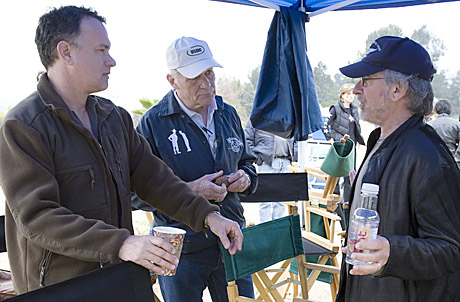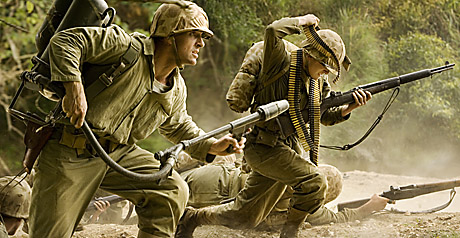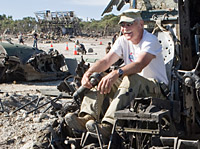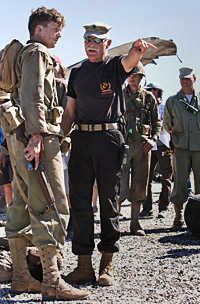Dale Dye describes work on HBO’s “The Pacific”

Tom Hanks, Capt Dale Dye and Steven Spielberg discuss filming on the set of HBO's "The Pacific." Photo by David James/HBO
By Capt. Dale Dye USMC (Ret), Senior Military Advisor on HBO’s “The Pacific.”
It took nearly two years of hard campaigning to get it right but in March of this year American TV audiences will get an unflinching, historically accurate and very absorbing look at World War II in the Pacific as fought by men of the vaunted 1st Marine Division.
In my billet as the Senior Military Advisor for this monster undertaking, Executive Producer Tom Hanks gave me a set of deceptively simple marching orders: “Get up under the helmet of those Marines and take the audience on the trip they made to hell and back between 1942 and 1945.” That’s what we did over the year we spent in shooting the project which HBO has given a simple, evocative title: “The Pacific.”

Actors portray members of the 1st MarDiv on the set of HBO's "The Pacific." Photo by Andrew Cooper/HBO
And it’s what HBO subscribers will see when the first episode of the maxi-series airs on March 14. Like its hugely successful predecessor “Band of Brothers,” this series will be presented on HBO in ten one-hour episodes with plans to sell a boxed set sometime following initial TV release. A series of special sneak previews are being set up around the country including one for 1st MarDiv Marines and WW II vets at Camp Pendleton. Given what I saw every day for a full year on sets in Australia where we shot the series and the edits I’ve seen done over the past year in post-production, there’s no question Marines are going to love this series but I believe it will also find a huge following among civilians and veterans of other services who will quickly lock on to the drama, pathos and hardships faced by men who fought the war in the Pacific. We certainly did our best and spared no expense to recreate it.
My orders to the Warriors Inc. cadre who assisted me in the training and in daily on-set advising were direct and specific. We will do everything in our power to give audiences an insight to the thoughts, emotions and passions of men who faced a brutal, tenacious and unfamiliar enemy in the Pacific campaigns of World War II. It was immediately obvious we were facing a big challenge and one that was quite different from what we faced in doing “Band of Brothers,” which focused on one company of paratroopers from the 506th PIR of the famed 101st Airborne Division in the ETO.
This new project required us to raise, train and employ actors and special ability extras who would realistically portray WW II-era Marines from all three regiments of the 1st Marine Division. The focus is on three main characters: Gunnery Sergeant John Basilone from 1st Battalion, 7th Marines, PFC Eugene Sledge from 3rd Battalion, 5th Marines and Private Robert Leckie of 2nd Battalion, 1st Marines as the division fought from Guadalcanal to Cape Gloucester, Peleliu and on to Okinawa. Much of the source material for our scripts was taken from books written by the latter two Marines (With the Old breed at Peleliu and Okinawa by Sledge and Helmet for My Pillow by Leckie) so we had at least two early touchstones for historical research.
We immediately worked out a Table of Organization for a training unit and began to sketch in the details of a schedule designed to produce a credible WW II Marine infantry company in the fourteen days allotted prior to start of principal photography. All hands on the Warriors Inc. crew were advised to pack their seabags for a long deployment and begin researching WW II Marine Corps weapons, equipment, uniforms and tactics.
In Melbourne, the city in which the 1st Marine Division rested after the grueling campaign on Guadalcanal in 1943, my XO Mike Stokey (1st MarDiv CC in Vietnam from 1966-69) and I began to recruit Special Ability Extras who would be trained along with the cast members and support the mission throughout the production. All of the three hundred or so young Australian or New Zealand men we saw in the process of selecting fifty candidates were avid to be a part of the production but few of them had much more than a rudimentary knowledge of World War II. These guys – and the actors who were being cast back in the States and in the UK – would need plenty of background information to effectively portray the young Americans who volunteered for Marine Corps service in World War II.
Stokey and I also used this trip to interview and hire thirty Asian extras that would be trained as Imperial Japanese infantrymen to oppose our Marines. We’ve always believed that the most effective portrayals of combat derive from using a skilled adversary rather than cartoon characters in enemy uniforms. For “The Pacific” we deemed this a vital concern. Despite propaganda portrayals from the period, IJA soldiers were anything but cartoons. Just ask any WW II Pacific combat veteran. To effectively communicate the jeopardy and the difficulties encountered by our forces facing tenacious and dedicated Japanese forces in the Pacific, we needed an on-screen enemy that demonstrated those characteristics.
As the principal actors began to arrive in Australia, we moved to Far North Queensland and set up for training in a huge patch of triple-canopy jungle running up the slopes of steep hills. With our CP established, we began to amass the weapons, ammunition, rations and canvas we’d require when the troops arrived. From this remote site we’d conduct a curriculum that ran the military gamut from terrain appreciation, through tactical formations and movement, to fire and maneuver and into combat engagements between our Marines and the Japanese forces training at a site nearby. We took an absolutely minimalist approach to creature comforts as we wanted our trainees to experience life in the field as it was lived by World War II Marines who were chronically short of everything except Japanese enemy.
Our training command was organized into three platoons: Assault Platoon, Machinegun Platoon and Mortar Platoon, each commanded by a Marine veteran and member of my Warriors staff. I commanded the training company with Stokey as my XO. When the troops arrived for transport to the training area, they were issued a seabag with World War II Marine dungarees, boondockers and period field equipment which left them both clueless and apprehensive. That situation was reinforced as the NCOs gave them a typical welcome based on personal experience with Marine Drill Instructors. It was loud, profane and scary which served to put our trainees in the desired mind-set: numb, sweaty and confused. That’s precisely the way we wanted them to be for reasons based on my own Marine Corps experience and what I’ve learned over the past 25 years about performing in military movies.
I’ve always believed the most effective training tactic is to work from the inside out rather than the other way around. You can train actors to walk, talk, maneuver and handle weapons appropriately – and that’s been done by others before me – but the real convincing performances come from the heart and from places deep in the brain that are unreachable without full and complete immersion in the alien experience of intimacy, lack of privacy, total inter-dependency, deprivation, hardship and unselfish devotion to a larger ideal that only those who have served in the military can understand. The idea is simply to give the performers a large, unavoidable dose of experience with the way real military people must feel, think and function to survive.
Any Leatherneck would recognize the regimen. Isolate them completely; no cell phones and no contact whatsoever with the world outside their training unit. From the start, work them hard in physical training and manual labor such as calisthenics, long formation runs and digging their own fighting positions until they are numb and focused exclusively on surviving the next five minutes. At that point, you have a blank slate and an open heart. We quickly launched on a steep learning curve during which the trainees gradually worked their way up into the appropriate positions of leadership and followership called for in the scripts.
A typical training day in the field went something like this. All hands muster at 0500 which was a bit shaky since we’d been on fifty percent alert throughout the previous night which was punctuated in thrilling fashion by a Japanese probe of our lines. No breakfast was allowed as we felt two ration meals in a 24 hour period would reduce body fat and give us the slim, slightly underfed look we’d need in the first episode covering Guadalcanal. We formed for PT at 0530, did calisthenics and then launched on a four-mile formation run. Following PT, we set the platoons against each other in full-contact close-quarters battle and bayonet drills with sheathed blades on M-1 rifles and carbines.
By 0800 we were on our firing line with blanks ammo streaming through Garand rifles, BARs and carbines. During our field training period, our people had to become intimately familiar not only with the M-1 rifle, carbine, Thompson SMG and BAR infantry combinations that Marines carried beginning in 1943 but they had to master the M1903A1 Springfield bolt-action rifles and M1917 water-cooled heavy machineguns required for the Guadalcanal sequences prior to the Corps’ adoption of the more modern weapons systems during WWW II.
While the riflemen worked on the firing line, Machinegun Platoon conducted gun drills – blank fire in support of maneuvering squads, displace, and re-engage area targets – while the Mortar Platoon conducted missions with the 60mm mortars firing creeping barrages with shells that give a satisfactory and attention-grabbing blast via 12-gauge shotgun shells embedded in the base of dummy HE rounds.
After noon chow, we briefed a company-sized reconnaissance patrol that would take us via compass heading through the heavy green to the top of a jungle covered hill where listening posts had reported enemy movement. Prior to moving out we issued the machetes we’d need to cut through the bush and conducted a review of field telephone and wire procedures that would keep everyone in contact with the CP. Field radios were notoriously unreliable in World War II and we reinforced that concept by requiring the Wire Section of Assault Platoon to constantly run lines and keep maneuvering units in contact via EE-8 field phones.
As we began to climb and cut through the tangle of vines and undergrowth under field marching packs (approximately 40 very real pounds of weight including rations and water) the heat smashed into us. The humidity in this jungle often matched the air temperature and those who rolled up their sleeves or unbuttoned their dungaree shirts rapidly became familiar with stinging nettles that added significantly to the agony of the march. The jungle climb was particularly difficult for machinegunners and mortarmen who had to hump all their T/E gear and a basic unit of fire. A pre-planned firefight with our Japanese training on the reverse slope of that jungle hill significantly lightened their load and gave them some excellent feeling for fighting at close range in a thick jungle. Machinegun crews had to constantly displace in support of the creeping infantry squads closing on enemy hard-points. Mortars were working their sights and tubes according to a rapid rate of adjustments I was sending to them via wire with the student officers observing the technique.
When we returned to the CP, cleaned all weapons and ate parts of a second meal, we opened the schoolhouse to conduct lectures on Marine Corps history, the state of the world and the U.S. in the war years, and worked on 1940s vocabulary and Marine jargon. When the inky darkness particular to Pacific jungles descended we set the watch and waited for the pre-planned, full-scale banzai assault that we’d arranged for some time close to 2200 when heads would be nodding on our perimeter. By the time we were hit in a sector defended by a pair of water-cooled machineguns, the troops were demonstrating admirable fire discipline. Our mortars fired a night area suppression mission to drive off the attackers.
And that was just one training day. Our final field exercise at the end of two weeks involved a full scale amphibious assault via period LVTs and LCIs on a heavily-defended beach. That was truly gratifying and as close as I’ll ever get to experiencing what our brothers in World War II faced on beachheads at places like Tarawa, Peleliu and Iwo Jima.
We paid meticulous attention to the details in uniforms, weapons, equipment and tactics. That’s an overdue tribute to the men who fought the great naval campaigns in the Pacific during World War II, Of course, there will be Marines, veterans and fans who will argue that we should have covered some of the other major Pacific battles. Vets of action with the 2nd, 3rd and 4th Marine Divisions might feel slighted, but we did include some sequences with the forming of the 5th MarDiv at Pendleton and we follow Basilone with that unit onto Iwo Jima where he was killed in action. It’s about all we could manage in bringing that under-appreciated, misunderstood and frequently forgotten aspect of World War II to life and to the attention of worldwide audiences.
There is one serious omission for which I should apologize, especially to this audience. Despite my best efforts, I never managed to talk the writers into including a Marine Corps Combat Correspondent in the action. But we did have a couple of real ones working behind the cameras and given our history and mission, I guess that’s the way it should be.

